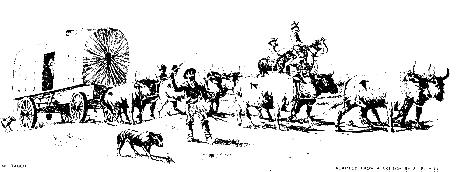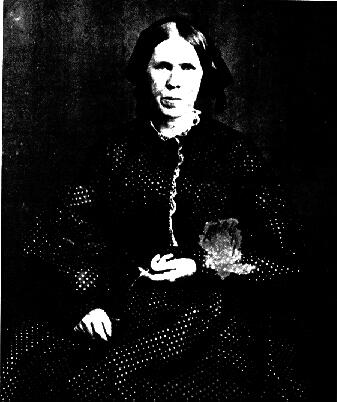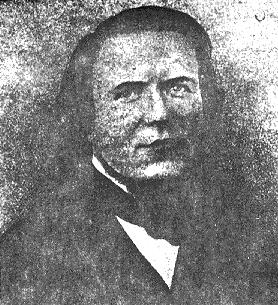The Members of the Donner Party
The group of emigrants who came to be known as the Donner Party did not set out as a single party. The Donner brothers and the Reeds set out from Springfield, Illinois, and traveled with the large group of emigrants under the captainship of Col. Russell. At the headwaters of the Sweetwater River, most of the last emigrants on the Trail who were headed to California via the Hastings Cut-off formed a company under George Donner’s leadership. It was not until the emigrant train reached the Wasatch Mountains east of the Great Salt Lake that the final stragglers arrived, completing the Donner Party.
Donner
The Donner brothers, George and Jacob, were considered prosperous, elderly farmers who had no reason to go to California. Born in North Carolina and descended from German immigrants, they had already migrated by wagon from the Atlantic to the Mississippi. Having heard of the wonders of California, they thought they would try one more migration. George, 60, brought his third wife, Tamsen, 45, their three children, Frances, 6, Georgia, 4 and Eliza, 3, and George’s two daughters from a previous marriage, Elitha Cumi, 14, and Leanna, 12.
Jacob Donner, 56, and his wife Elizabeth, 45, brought their five children, George, 9, Mary, 7, Isaac, 5, Samuel, 4 and Lewis, 3, and Mrs. Donner’s two children from a previous marriage, Solomon Hook, 14, and William Hook, 12.
Each of the Donner brothers had three wagons, and they brought two teamsters, Noah James, 20 and Samuel Shoemaker, 25. Also traveling with the Donners, perhaps as a teamster, but also as a friend, was John Denton, 28, from Sheffield, England.
Reed
The Reed family consisted of James Frazier Reed, 46, his wife Margaret W. Reed, 32, and their three children, Martha (called Patty), 8, James Jr., 5, and Thomas, 3. Also part of the family was Mrs. Reed’s daughter from a previous marriage Virginia Backenstoe Reed, 13, and Mrs. Reed’s mother Sarah Keyes, 75. Accompanying the family were five employees: a servant, Eliza Williams, 25, her half-brother Baylis Williams, 24, and three teamsters: Milford (Milt) Elliott, 28, Walter Herron, 25 and James Smith, 25. Hiram Miller also traveled with the Reeds as an employee.

James and Margaret Reed
Reed was born in northern Ireland and came to the US as a child with his family. He served in the Black Hawk campaign in the same company as Abraham Lincoln, and had prospered as a merchant and furniture maker. Apparently, a turnaround in his business led him to try his luck in California. He intended to meet his brother-in-law Robert Cadden Keyes who had left for Oregon in 1845, but instead went to California with William Brown Ide. Robert Keyes apparently intended to meet the Reeds on the Trail.
James Reed’s wealth was reflected in his wagons, as described by his step-daughter 45 years later:
Our wagons, or theReed wagonsas they were called, were all made to order and I can say without fear of contradiction that nothing like our family wagon ever started across the plains. It was what might be called a two-story wagon orPioneer palace car,attached to a regular immigrant train. My mother, though a young woman, was not strong and had been in delicate health for may years, yet when sorrows and dangers came upon her she was the bravest of the brave. Grandma Keyes, who was seventy-five years of age, was an invalid, confined to her bed. ... So the car in which she was to ride was planned to give comfort. The entrance was on the side, like that of an old-fashioned stage coach, and one stepped into a small room, as it were, in the centre of the wagon. At the right and left were spring seats with comfortable high backs, where one could sit as on the seats of a Concord coach. In this little room was placed a tiny sheet-iron stove, whose pipe, running through the top of the wagon, was prevented by a circle of tin from setting fire to the canvas cover. A board about a foot wide extended over the wheels on either side the full length of the wagon, thus forming the foundation for a large and roomy second story in which were placed our beds. Under the spring seats were compartments in which were stored many articles useful for the journey.
We had two wagons loaded with provisions. ... Certainly no family ever started across the plains with more provisions or a better outfit for the journey; ... The family wagon was drawn by four yoke of oxen, large Durham steers at the wheel. The other wagons were drawn by three yoke each. We had saddle horses and cows, and last but not least my pony.

Reed’s Pioneer Palace Car, drawn for Virginia Reed’s 1891 article
Breen
The Breen family consisted of Patrick Breen, 51, his wife Margaret (Peggy), 40, and their seven children: John, 14, Edward, 13, Patrick, Jr., 11, Simon, 9, Peter, 7, James, 5, and Isabella, l.

Patrick Breen

Margaret "Peggy" Breen
According to a memoir by John Breen, written on November 19, 1877 for the historian H.H. Bancroft,
My father and mother were born in Ireland, they came to America about 1828 where I the oldest of a family of nine was born in the year 1832, my father with his family, settled in the Territory of Iowa in 1835 where he remained until the fifth of April 1846. Then he with my mother and six brothers and one sister started for California my father had for several years talked of going to California or Oregon.
According to King’s research, Patrick Breen arrived in Canada in 1828, married Margaret Bulger (whom he called Peggy
) and in 1834, they and two infant sons moved to Springfield, Illinois. Their property in Iowa Territory, near the town of Keokuk, is unmarked, but can be reached by the present Wirtz Lane, a gravel road off North Main Street.
Eddy
William Eddy, 28, was a carriage maker from Belleville, Illinois. With him was his wife Eleanor, 25, and their two children James, 3, and Margaret, 5. The Eddys had one wagon.

William Eddy
Murphy
Lavinia Jackson Murphy, 50, widow of Jeremiah Burns Murphy of North Carolina, traveled with her seven children. Five were young: Landrum, 15, Mary, 13, Lemuel, 12, William, 11 and Simon, 10. The two eldest were married with children of their own: Sarah, 23, and her husband William Foster, 28, had a son George, 4. Harriet, 21, and her husband William Pike, 25, had two children, Naomi, 3, and Catherine, 1. The Murphys had two wagons.
According to William Murphy, in a lecture he gave in 1896,
In 1845 we heard wonderful stories of a wonderful country in the far West, between the Pacific ocean and the Rocky mountains, a country of sulubrious climate, perrenial spring time indeed, of deep and inexhaustible soil, why, they said that wheat grew wild higher than a man’s head, and the Mexican Government that exercised some kind of control over it, would grant land to settlers; so my mother, as a widow, with seven children, two sons-in-law and three grand children, suggested that we emigrate to the far off fairy land. She ordered a suitable wagon to be manufactured, a son-in-law did the same, and early in 1846, we started out with two ox teams from West Tennessee, crossed the State of Kentucky, the Ohio river below Paducah, up through Illinois, to Ballville, opposite St. Louis, crossed the Mississippi there, taking a family of three of ours who lived there, completing our number-thirteen. Across the State of Missouri to Independence, then the great entry port of the overland trade of Northern Mexico and Santa Fe; here we learned that the great overland caravan for Oregon and California had departed. We concluded to overtake them, which we did at the Big Blue, in Kansas, where they were water bound. Here we first met the Donners.
Keseberg and Hardkoop
Lewis (or Louis) Keseberg, 32, and his wife, Philippine, 23, left their Ohio home with a daughter, Juliane (called Ada
), 3. Their son, Lewis, Jr., was born on the Trail. Keseberg was originally from Berleburg, Westphalia, and was well-educated, speaking four languages. The Kesebergs had two wagons, the second one handled by their teamster Charles Berger (or Karl Burger), 30. Also traveling with the Kesebergs, at least after Fort Bridger, was the old Belgian Hardkoop, about 60, from Cincinatti.
Wolfinger, Spitzer and Reinhardt
A man named Wolfinger, about 26, and his wife Doriss, 19, had one wagon. Perhaps traveling with the Wolfingers, or perhaps traveling in their own wagon, at least for part of the journey, were two partners Augustus Spitzer and Joseph Reinhardt, about 30.
McCutchen
William McCutchen, 30, from Jackson County, Missouri, was traveling with his wife Amanda, 30, and their daughter Harriet, 1. When they joined the Donner Party at Fort Bridger they apparently had no wagon, although there are references to the McCutchens
in diaries earlier in the journey which indicate they may have had a wagon or been a part of another party.
Graves
Franklin Graves, 57, from Sparland, Illinois, and his wife Elizabeth, 47, traveled with their nine children. The eldest daughter, Sarah, 22, was with her husband Jay Fosdick, 23. The other children were Mary, 20, William, 18, Eleanor, 15, Lovina, 13, Nancy, 9, Jonathan, 7, Franklin, Jr., 5, and Elizabeth, 1. The Graves had three wagons, one driven by their teamster John Snyder, 25. The Graves began their journey with the Smith company, which was the last party on the Trail in ’46. Most of the Donner Party began with the Russell Company. The Graves caught up with the Donners in the Wasatch Mountains in August.
Stanton
Charles Stanton, 35, was born in Pompey, New York, but was most recently from Chicago, where he seemed to have not fared well in business. Casting about for something new, Stanton found traveling to his liking and decided to head to California. King states that Stanton travelled as an employee of the Donners, but from Stanton’s letters it is more likely that Stanton had simply arranged for the Donners to haul his goods, as others had done for him earlier on the Trail.

Charles Stanton
Halloran, Antonio and Trudeau
Luke Halloran, about 25, was a merchant from Missouri. Halloran was suffering from consumption, and had been put out by his former companions. He approached the Donners at the Little Sandy River in Wyoming, and rode in their wagons.
Somewhere along the trail Antonio, about 23, a shepherd from New Mexico, joined the Donners.
At Fort Bridger, the Donners hired Jean Baptiste Trudeau, 18, as an additional hand. Trudeau was the son of a French-Canadian trapper who plied the fur trade from St. Louis. Trudeau joined Fremont and Carson in 1845, as far as the Green River, where he accompanied James Hudspeth of the Hastings Party as far as Fort Bridger.